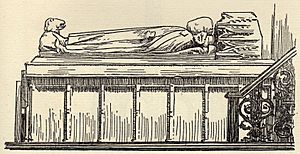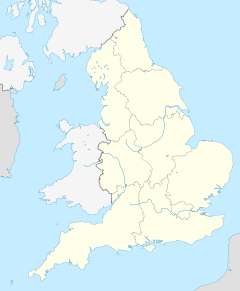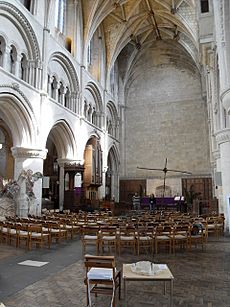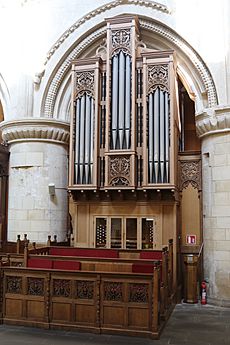Malmesbury Abbey facts for kids
Quick facts for kids Malmesbury Abbey |
|
|---|---|

The main entrance (the South Porch) seen from the graveyard, showing the modern extent of the Abbey
|
|
| Religion | |
| Affiliation | Church of England |
| Location | |
| Location | Malmesbury, Wiltshire, England |
| Country | United Kingdom |
| Architecture | |
| Architectural type | Abbey |
| Groundbreaking | 7th century |
Malmesbury Abbey is a very old and important church located in Malmesbury, Wiltshire, England. It is dedicated to Saint Peter and Saint Paul. This abbey is special because it has been a religious place since the 600s. It continued to be used right up until the time when many monasteries were closed down in England.
Contents
History of Malmesbury Abbey
The story of Malmesbury Abbey began in the late 600s. An Irish monk named Maildubh chose this spot. He started a small hermitage, which was a quiet place where he lived and taught local children. Later, the area was taken over by the Anglo-Saxons.
Around 676, a famous scholar and poet named Aldhelm founded Malmesbury Abbey. It became a Benedictine monastery, which is a community where monks live and follow the rules of Saint Benedict. The town of Malmesbury grew up around the Abbey. Under Alfred the Great, it became an important fortified town.
Royal Burials and Learning
In 941 AD, King Æthelstan was buried at the Abbey. He is often called the first king of England. Choosing Malmesbury for his burial showed that he was not fully part of the usual royal court. A place for making coins was also set up at the Abbey around this time.
Malmesbury Abbey became very famous for its learning. Scholars like Aldhelm, John Scotus Eriugena, and Aelfric of Eynsham studied and taught there. By the 1000s, it had one of the biggest libraries in Europe. It was seen as a top place for education.
A Monk's Flight Attempt
The Abbey was also the site of an amazing early attempt at human flight! In the early 1000s, a monk named Eilmer of Malmesbury attached wings to his body. He then jumped from a tower. Eilmer flew for over 200 yards (about 180 meters) before landing and breaking both his legs. He later said he would have flown further if his glider had a tail!
The Domesday Book of 1086, which was a big survey of England, mentioned the Abbey's wealth. It owned many lands across different areas, showing how powerful and rich it was.
The famous 12th-century historian William of Malmesbury was also a monk at the Abbey.
Building and Collapses
The main parts of the Abbey we see today were mostly finished by 1180. However, the Abbey has suffered from collapses over time. Around 1500, its very tall spire (a pointed roof) and the tower it stood on fell down in a storm. This destroyed a large part of the church, including two-thirds of the main hall (the nave) and the cross-shaped parts (the transept).
Malmesbury Abbey as a Parish Church
The Abbey was a very wealthy place, owning a lot of land. In 1539, during the Dissolution of the Monasteries, King Henry VIII closed it down. He sold the Abbey and its lands to a rich merchant named William Stumpe.
William Stumpe was important because he gave the Abbey church back to the town. This meant it could continue to be used as a local church. He also used other Abbey buildings for his cloth-weaving business, setting up many looms inside.
Around 1550, the western tower of the Abbey also fell. Because of these two collapses, less than half of the original huge building is still standing today.
During the English Civil War (in the 1600s), Malmesbury was a battleground. The Abbey was fought over many times. You can still see hundreds of small marks on the Abbey walls. These are pock-marks left by bullets and cannon shot from the fighting!
In 1949, Malmesbury Abbey was named a Grade I listed building. This means it is a very important historical building.
Today, Malmesbury Abbey is still fully used as the local parish church for Malmesbury. It has a beautiful room called a parvise that holds some old books from the Abbey's library. Old documents from Malmesbury Abbey are still used by historians today to learn about the history of Wessex and the church from the 600s.
The Abbey Organ
The Abbey has had several organs over the years. The first one was brought in 1846. It had been built in 1714 by Abraham Jordan. In 1938, a new organ was installed.
The organ used today was built in 1984 by E.J. Johnson of Cambridge. It cost £71,000 at the time.
Famous Burials

Several important people are buried at Malmesbury Abbey or in its churchyard:
- Máel Dub: The monk who started the first religious community here.
- Aldhelm: The first Bishop of Sherborne and a saint.
- Æthelstan: Regarded as the first king of England. His body was moved several times to protect it. There is an empty tomb in the Abbey that honors him.
- Hannah Twynnoy: She is supposedly the first person in England to be killed by a tiger! She was buried in the churchyard in 1703. Her gravestone has a poem about how she was killed after teasing a tiger.
- Roger Scruton: A famous writer and philosopher who lived near Malmesbury. He was buried in the churchyard in 2020.
Abbey's Legacy
In 2009, historian Michael Wood suggested that the famous Anglo-Saxon poem Beowulf might have been written down at Malmesbury Abbey. This shows the Abbey's long history of learning and culture.
Images for kids
-
The Abbey interior; the ruined area lies beyond the blank wall rising above the altar
See also
 In Spanish: Abadía de Malmesbury para niños
In Spanish: Abadía de Malmesbury para niños






